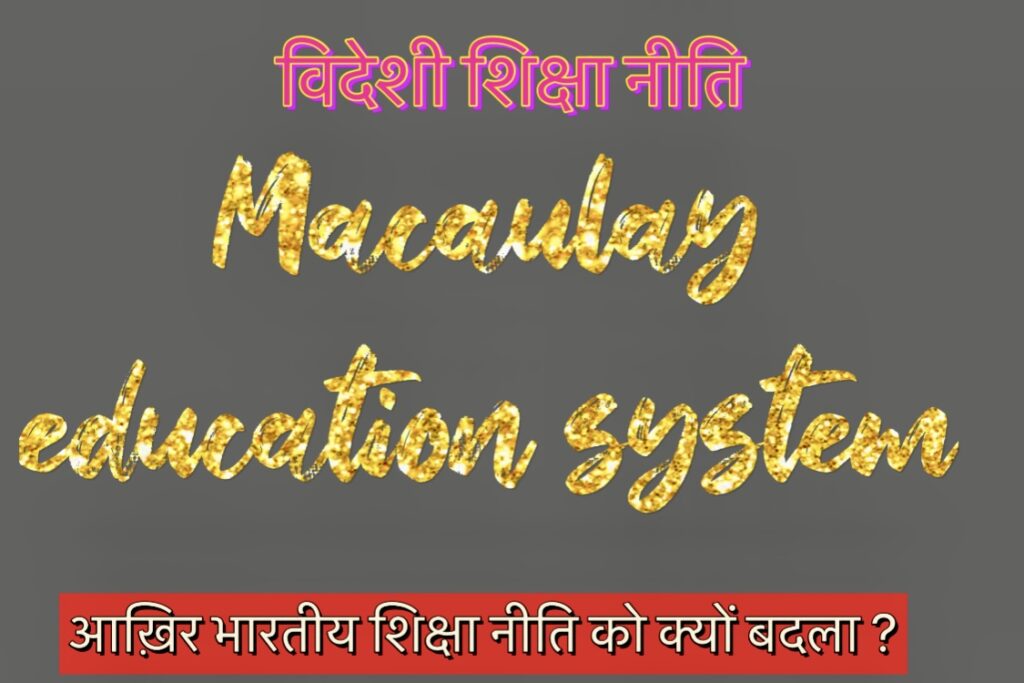Macaulay education system

मैकॉले शिक्षा पद्धति का संदर्भ उस शिक्षा प्रणाली से है, जिसे ब्रिटिश उपनिवेशकाल के दौरान भारत में लागू किया गया था। इसे 1835 में थॉमस बबिंगटन मैकॉले द्वारा पेश किया गया था, जिन्होंने ब्रिटिश हुकूमत के तहत भारत में अंग्रेज़ी शिक्षा प्रणाली की नींव रखी। मैकॉले ने अपनी प्रसिद्ध “मिनट ऑन इंडियन एजुकेशन” में भारतीय शिक्षा प्रणाली को बदलने और अंग्रेज़ी को शिक्षा का माध्यम बनाने का प्रस्ताव रखा।
मैकॉले शिक्षा पद्धति के प्रमुख तत्व
अंग्रेज़ी भाषा का प्रचार
मैकॉले ने प्रस्तावित किया कि शिक्षा का माध्यम अंग्रेज़ी होना चाहिए। उनका मानना था कि अंग्रेज़ी भाषा भारतीयों को पश्चिमी ज्ञान और विज्ञान तक पहुंच प्रदान करेगी और ब्रिटिश शासन के लिए शिक्षित भारतीयों का एक वर्ग तैयार होगा।
भारतीय भाषाओं और पारंपरिक शिक्षा की उपेक्षा
मैकॉले ने भारतीय भाषाओं और पारंपरिक शिक्षा प्रणाली को ‘अयोग्य’ और ‘निम्न’ माना। उन्होंने संस्कृत, फारसी, और अरबी जैसी भाषाओं में दी जाने वाली शिक्षा को महत्वहीन बताया, और इसीलिए अंग्रेज़ी भाषा को प्राथमिकता दी गई।
नौकरशाही के लिए कर्मठ वर्ग का निर्माण
मैकॉले का उद्देश्य भारत में एक ऐसा शिक्षित वर्ग तैयार करना था, जो ब्रिटिश शासन के तहत काम कर सके। यह वर्ग प्रशासनिक नौकरियों में कार्य करने के लिए तैयार किया गया था और इसका काम भारतीयों पर ब्रिटिश कानून और संस्कृति लागू करना था।
मैकॉले का उद्धरण “हमें एक ऐसा वर्ग तैयार करना है जो रंग और खून से भारतीय हो, लेकिन सोचने और कार्य करने के तौर पर अंग्रेज़ हो” इस नीति को स्पष्ट करता है।
व्यावहारिक और वैज्ञानिक शिक्षा की कमी
हालांकि इस प्रणाली में अंग्रेज़ी शिक्षा को बढ़ावा दिया गया, परंतु वैज्ञानिक, तकनीकी और व्यावसायिक शिक्षा की कमी रही। यह प्रणाली मुख्य रूप से साहित्य, कानून, और प्रशासनिक विषयों पर केंद्रित थी।
ब्रिटिश संस्कृति और नैतिकता का प्रसार
इस शिक्षा प्रणाली के तहत भारतीयों को पश्चिमी संस्कृति, नैतिकता और मूल्यों से परिचित कराया गया। इसका उद्देश्य भारतीय समाज को ब्रिटिश संस्कृति और जीवनशैली के अनुरूप ढालना था।
मैकॉले शिक्षा पद्धति का प्रभाव
भारतीय समाज का पश्चिमीकरण
मैकॉले की शिक्षा नीति ने एक पश्चिमी दृष्टिकोण और विचारधारा को बढ़ावा दिया। इसके परिणामस्वरूप भारत अपने ही लोगो के अविष्कार और ज्ञान भूल गया और उन्होंने ब्रिटिश शासन के प्रति वफादारी दिखाई और भारतीय परंपराओं और संस्कृतियों को कमतर माना।
भारतीय भाषाओं और पारंपरिक शिक्षा का पतन
इस नीति के तहत भारतीय भाषाओं और पारंपरिक शिक्षा प्रणाली को गंभीर नुकसान हुआ। संस्कृत, फारसी और अरबी जैसी भाषाओं में दी जाने वाली उच्च शिक्षा को दरकिनार कर दिया गया।
शिक्षा में असमानता
मैकॉले की शिक्षा प्रणाली का उद्देश्य सभी भारतीयों को शिक्षा प्रदान करना नहीं था, बल्कि एक छोटे वर्ग को शिक्षित करना था, जो ब्रिटिश शासन की सहायता कर सके। इसका परिणाम यह हुआ कि आम भारतीय जनता शिक्षा से वंचित रह गई, और यह असमानता आजादी के बाद भी शिक्षा प्रणाली में देखी जा सकती है।
भारत में प्रशासनिक सेवाओं का गठन
इस शिक्षा पद्धति ने भारतीय प्रशासनिक सेवाओं (IAS) जैसे क्षेत्रों के लिए एक आधार तैयार किया, जिसमें अंग्रेज़ी शिक्षा प्राप्त भारतीयों को नौकरशाही में जगह मिली।
मैकॉले शिक्षा पद्धति की आलोचना
संस्कृति का दमन
इस प्रणाली ने भारतीय संस्कृति, इतिहास, और परंपराओं को पूरी तरह से दरकिनार किया। भारतीय परंपराओं, लोक ज्ञान और भाषाओं को उपेक्षित कर केवल अंग्रेज़ी और पश्चिमी संस्कृति को महत्व दिया गया।
सामाजिक और शैक्षिक असमानता
इस पद्धति ने केवल एक छोटे वर्ग को शिक्षित किया और शिक्षा का प्रसार आम जनता तक नहीं हो पाया। इससे समाज में असमानता और बढ़ी।
व्यावहारिक ज्ञान की कमी
इस प्रणाली में व्यावसायिक और वैज्ञानिक शिक्षा पर ध्यान नहीं दिया गया, जो भारत के समग्र विकास के लिए आवश्यक थी।
निष्कर्ष
मैकॉले शिक्षा पद्धति भारत के इतिहास में एक महत्वपूर्ण मोड़ थी, जिसने भारतीय समाज को शिक्षा और भाषा के संदर्भ में पूरी तरह बदल दिया। हालांकि, इसने भारत में एक शिक्षित वर्ग तैयार किया, जिसने आधुनिक भारत के निर्माण में महत्वपूर्ण भूमिका निभाई, लेकिन इसके परिणामस्वरूप भारतीय भाषाओं और परंपराओं का ह्रास हुआ। हालांकि इसे सीधे तौर पर साजिश कहना उचित नहीं होगा, लेकिन इसके माध्यम से भारतीय संस्कृति, भाषा और परंपराओं को कमजोर करने की दिशा में एक सोची-समझी योजना अवश्य दिखाई देती है। इसके दीर्घकालिक प्रभावों ने भारतीय समाज को गहरे स्तर पर प्रभावित किया, और कई मायनों में इसे एक सांस्कृतिक साजिश के रूप में देखा जा सकता है।
Macaulay education system refers to the education system that was implemented in India during the British colonial period. It was introduced in 1835 by Thomas Babington Macaulay, who laid the foundation of the English education system in India under British rule. Macaulay proposed to change the Indian education system and make English the medium of instruction in his famous “Minute on Indian Education”.
Key Elements of Macaulay Education System
Promotion of English Language
Macaulay proposed that the medium of education should be English. He believed that the English language would give Indians access to Western knowledge and science and create a class of educated Indians for British rule.
Neglect of Indian Languages and Traditional Education
Macaulay considered Indian languages and traditional education system ‘unworthy’ and ‘inferior’. He termed education imparted in languages like Sanskrit, Persian, and Arabic as unimportant, and hence preferred the English language.
Creation of a working class for bureaucracy Macaulay’s aim was to create an educated class in India that could work under British rule. This class was prepared to work in administrative jobs and its job was to impose British law and culture on Indians.
Macaulay’s quote “We have to create a class that is Indian in colour and blood, but English in thought and action” clarifies this policy.
Lack of practical and scientific education
Although English education was promoted in this system, there was a lack of scientific, technical and vocational education. This system mainly focused on literature, law, and administrative subjects.
Spread of British culture and morality
Under this education system, Indians were introduced to Western culture, morality and values. Its aim was to mold Indian society to suit British culture and lifestyle.
Effect of Macaulay’s education system
Westernization of Indian society
Macaulay’s education policy promoted a Western outlook and ideology. As a result, India forgot the inventions and knowledge of its own people and showed loyalty to the British rule and treated Indian traditions and cultures as inferior.
Decline of Indian Languages and Traditional Education Indian languages and traditional education system suffered severely under this policy. Higher education in languages like Sanskrit, Persian and Arabic was sidelined.
Inequality in Education
The aim of Macaulay’s education system was not to provide education to all Indians, but to educate a small class, who could help the British rule. The result was that the common Indian masses were deprived of education, and this inequality can be seen in the education system even after independence.
Formation of Administrative Services in India This education system laid a foundation for fields like the Indian Administrative Services (IAS), in which English-educated Indians got a place in the bureaucracy.
Criticism of Macaulay’s Education System
Suppression of Culture
This system completely sidelined Indian culture, history, and traditions. Indian traditions, folk knowledge and languages were neglected and only English and Western culture were given importance.
Social and educational inequality
This system educated only a small section and education could not spread to the general public. This further increased inequality in the society.
Lack of practical knowledge
This system did not focus on vocational and scientific education, which was necessary for the overall development of India.
Conclusion
The Macaulay education system was a turning point in the history of India, which completely changed the Indian society in terms of education and language. Although it created an educated class in India, which played an important role in the creation of modern India, it also resulted in the decline of Indian languages and traditions. Although it would not be appropriate to call it a conspiracy outright, but through this a well-thought-out plan is definitely visible towards weakening the Indian culture, language and traditions. Its long-term effects affected the Indian society at a deep level, and in many ways it can be seen as a cultural conspiracy.






Somebody essentially lend a hand to make significantly articles Id state That is the very first time I frequented your website page and up to now I surprised with the research you made to make this actual submit amazing Wonderful task
Thank-you for your valuable feedback